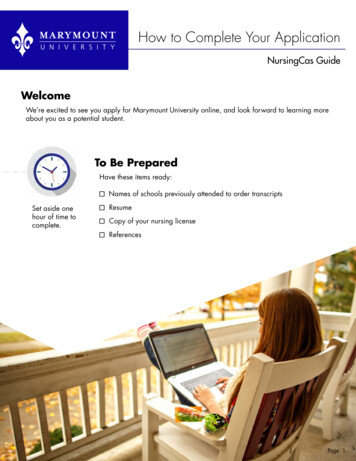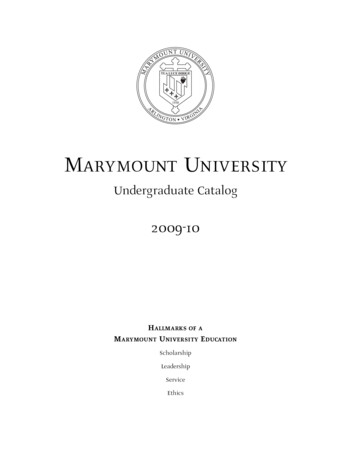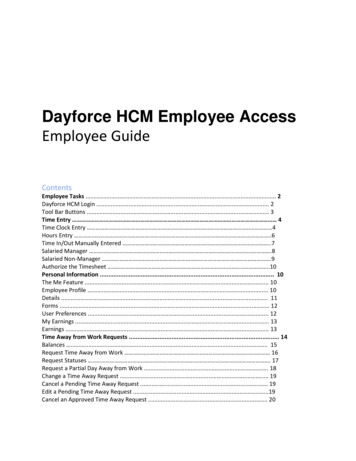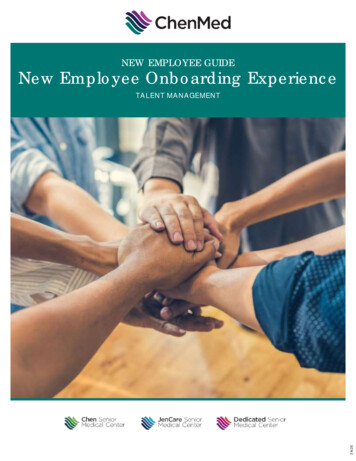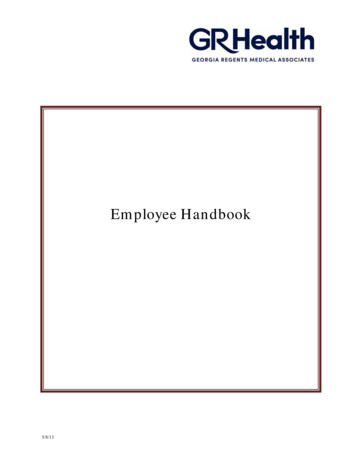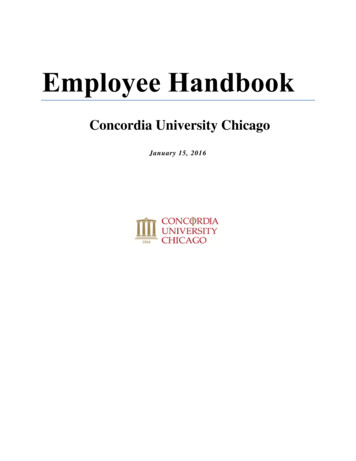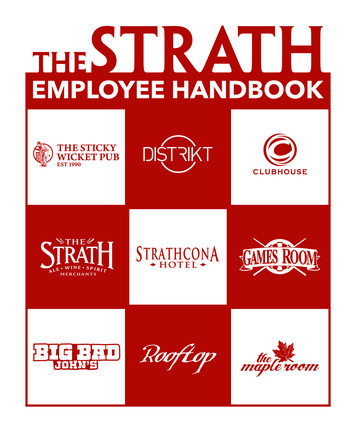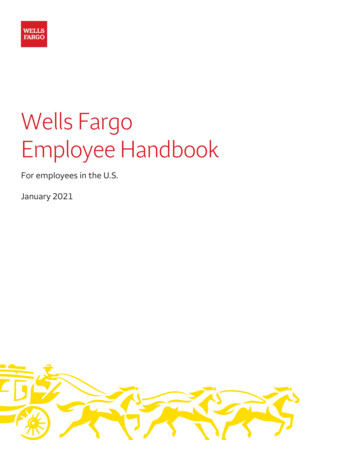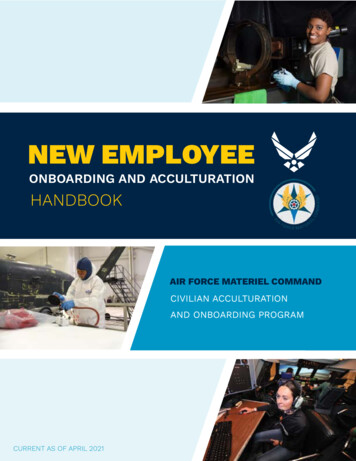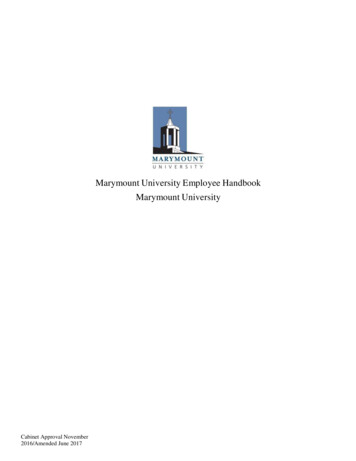
Transcription
Marymount University Employee HandbookMarymount UniversityCabinet Approval November2016/Amended June 2017
Marymount University Employee Handbook2PREAMBLEThe Marymount University’s Employee Policies and Procedures Manual (Employee PP Manual) is areference guide for ALL EMPLOYEES: staff, faculty, and administrators that is designed to provideaccurate and timely information on university policies that relate to the employment relationship with theuniversity.The goal of this Manual is to be both current and consistent with Federal employment laws and regulations, andthe best available evidence supporting the discipline of Human Resources Management.Administrators, faculty, and staff are encouraged to use this Manual for consistent application of universitypolicies. Most policies apply universally across employee categories; however exceptions exist and are dulynoted as such. Alternative documents of the university including, but not limited to, the Full-Time FacultyHandbook, Part-Time Faculty Handbook, and Student Handbook are referenced for additional and/orappropriate policy information.Changes to the ManualThe Manual and the policies, procedures, and benefits described herein are intended to be dynamic, that is,subject to ongoing review. The university reserves the right to amend, modify, or terminate policies, procedures,and benefits plans at any time. Consistent with the university’s practice of shared governance. Faculty and StaffCouncils provide meaningful input to any proposed chances. Approved changes are communicated to allemployees.Cabinet Approval November2016/Amended June 2017
Marymount University Employee Handbook3Table of ContentsMARYMOUNT UNIVERSITY’S STRATEGIC PLAN6MU Vision: Building the University of Choice6Service Quality Principles7MARYMOUNT UNIVERSITY HRS MISSION8Human Resource Services Management Philosophy8Human Resource Services Mission and Purpose8GENERAL UNIVERSITY POLICIES8Standards of Conduct and Non-Compliance8Employer-Employee Employment Relationship9Equal Employment Opportunity10Harassment, Discrimination, and Retaliation10Harassment via Electronic Messaging and Information Systems13Sexual Harassment and Interpersonal Misconduct14Protection of Minors and Mandatory Reporting of Suspected Child Abuse15Conflict of Interest15Consensual Relationships17Employee-Student Dating18Drug-Free Work Place18Drug and Alcohol Usage and Testing18Alcohol in the Work Place19Americans with Disabilities Act (ADA)19Violence in the Work Place19Emergency Situations and Emergency Preparedness20Emergency and Non-Emergency Transportation Policy20Vehicle and Driver Safety Policy21Use of Technology Resources Policy23Telephone Calls, University Cell Phones and University Address24Cell Phone Policy24Social Media Policy24Bullying25Smoke-Free Campus Policy25Cabinet Approval November2016/Amended June 2017
Marymount University Employee Handbook4Animals on Campus Policy26Service Animal Policy26Nursing Mothers Policy26CLASSIFICATION AND COMPENSATIONPay PhilosophyWAGES AND HOURS272728Hours of Work28Electronic Time Records28Maintenance of Time Records28Overtime Rules29Payday Schedule29Payroll Deductions29Authorization to Withhold Pay30Garnishments and Wage Assignments30Paycheck Errors30Flexible Scheduling and Work Arrangements Policy30RECRUITMENT PRACTICES31Overview of Employment Process31Recruitment and Hire (Non-Faculty)31Recruitment and Hire (Full-Time Faculty Appointments)31Advertising32Pre-Employment Requirements32Immigration Sponsorship Application32Conditional Offer of Employment32New Employee Orientation and Plan for Retention32EMPLOYMENT PRACTICES33Employment Categories33Employment of Holy Day Observers33Introductory Period34Employment Verifications34Cabinet Approval November2016/Amended June 2017
Marymount University Employee Handbook5Return of Former University Employee to Active Employment34Other Worker Classifications34Promotion and Transfer of Non-Faculty Employees36Licensure, Registration, and Certification36Personal Appearance37Notification Protocol37SEPARATIONS37All Separations from Active University Employment37Voluntary Separation: Resignation38Involuntary Separation from Active University Employment39Check Releases40Date of Termination40LEAVE40Annual Leave (Non-Faculty)40Holidays42Inclement Weather Absence42Jury Duty Leave42Condolence/Bereavement Leave43Sick Leave43Sick Leave Bank44Shift Differentials44Family Medical Leave45Disability Insurance Plans46Military Leave46Faculty Leave of Absence-Without Pay46BENEFITS47Exempt and Non-Exempt Employees Summary47Healthcare Insurance47Life and Long Term Care Insurance47Disability Benefits48Tuition Remission and Exchange Programs48Cabinet Approval November2016/Amended June 2017
Marymount University Employee Handbook6RETIREMENT50EMPLOYEE RELATIONS51Performance Expectations51Employee Grievance Procedure51STANDARDS OF CONDUCT AND PROGRESSIVE DISCIPLINE PROCESS52ABSENTEEISM AND TARDINESS53EMPLOYEE DEVELOPMENT AND WELFARE54RECORDS MANAGEMENT54Recordkeeping Requirements54Personnel Records54GOVERNANCE55Faculty Council55Staff Council55University Standing Committees56DEFINITIONSCabinet Approval November2016/Amended June 201756
Marymount University Employee Handbook7MARYMOUNT UNIVERSITY’S STRATEGIC PLANHR I-1Marymount University Vision: Building the University of ChoiceMarymount Vision StatementMarymount University will be known as a comprehensive Catholic University and the institution ofchoice for students, faculty, and staff. Marymount will distinguish itself through a culture ofengagement that fosters intellectual curiosity, service to others, and a global perspective.Core Values Excellence – The Marymount community consistentlystrives for excellence in carrying out the university’svision and mission. Integrity – The Marymount community conducts allactivities and interactions in an authentic, transparent, andethical manner. Professionalism – The members of the Marymountcommunity exhibit professionalism in all their activitiesand interactions and maintain a sense of accountability. Diversity –The Marymount community welcomes andvalues all individuals and recognizes diversity as a sourceof strength. Respect –The Marymount community maintains andpromotes an atmosphere of mutual respect, cooperation,and civility. Faith – The members of the Marymount communityshare a commitment to moral and spiritual growth and,consistent with the Catholic intellectual tradition, arecommitted to living examined, purposeful lives Service – The members of the Marymount communityactively seek to serve others and advance social justice.Organizational Climate Encourage a sense of caring and concernfor all its members Instill a feeling of commitment andresponsibility to the organization Create fluid organizational boundaries thatpromote collaboration and teamwork acrossthe organization Provide an environment where allcommunity members feel valued and sharea sense of purpose and pride Foster an environment that is open todiverse thoughts, perspectives, and beliefs Ensure that important information isbroadly and accurately communicated andprocesses that affect the organization andthe community are transparent Recognize and celebrate communitymembers’ contributions andaccomplishments Continually monitor its progress inmaintaining a positive institutional climateand living its core valuesMarymount University is a Catholic institution of higher education committed to excellence in teaching,learning, scholarship, and service. As such, the university acknowledges these specific core values that guideand govern the actions of its community.The Marymount community is committed to exemplifying these core values through ethical conduct in allendeavors and interactions. By teaching and modeling ethical behavior, MU builds character and citizenshipand prepares its graduates for lives of true personal and professional success. These values apply to all membersof the Marymount community, including students, faculty, staff, administrators, board members, consultants,vendors, and others engaged in business with the university. Each member of the community is responsible forconducting him or herself in accordance with these values and other university policies and regulations. Formore information on the MU Strategic Plan: MU Strategic PlanCabinet Approval November2016/Amended June 2017
Marymount University Employee Handbook8HR I-2 Service Quality PrinciplesWe Are Marymount: Our Service Quality Guiding PrincipleWe foster positive, transparent, collaborative, and cooperative interactions with students, each other, parents,and visitors to be the institution of choice for students, staff, and faculty. We will: Create a welcoming atmosphereo Be friendly, helpful, and caringo Demonstrate positive behavior in public areaso Smile and offer a warm greetingo Approach each encounter with a positive and productive attitude Anticipate and meet needso Practice active and careful listeningo Ask questions for better understandingo Look for opportunities for continuous improvement Provide accurate and quality assistanceo Be knowledgeable about the university’s organization and operationso Be consistent and provide the same quality of service to everyoneo Attend to the detailso Respond to all communications within two business dayso Set and publish departmental expectations for appropriate resolutions Treat others as valued individualso Have a respectful demeanor in all interactionso Provide unconditional concern for the well-being of otherso Encourage and expect the best in everyone Provide service in keeping with our Catholic Identityo Be committed to serve otherso Go beyond what is expectedo Show a sincere interest in helping Take personal responsibility and ownership of Marymount and your individual role in ito Have pride in the job you performo Believe that what you do matterso See the situation through to resolutiono Present yourself professionallyCabinet Approval November2016/Amended June 2017
Marymount University Employee Handbook9HR II HUMAN RESOURCE SERVICES MISSIONHR II-1 Human Resource Services Management PhilosophyMU recognizes that people are our most valuable asset, and it is our objective to design personnel programs andactivities in order to plan for, acquire, organize, develop, and retain our faculty and staff. These programs andactivities include the selection and development of persons with the requisite skills to effectively fill staffingneeds; the provision of appropriate compensation and benefits; the development of effective employee relations;the implementation of a broad-based staff education and training program; and adherence to a system ofcomprehensive employee-centered administration.HRS management takes place at every level of the organization and is subject to all elements of themanagement process: planning, organizing, communicating, motivating, and oversight. It is the responsibility ofall MU employees to help identify management issues and bring them to the attention of the HRS. Whereappropriate, such matters, with recommended solutions, shall be referred to, and be reviewed with theappropriate levels within MU and areas for discussion and decisions.HR II-2 Human Resource Services Mission and PurposeThe policies and practices of Human Resource Services (HRS) support the university’s mission, organizationalobjectives, increase organization and individual productivity, are cost conscious and cost effective, promote asatisfying work environment, and comply with the applicable requirements of accreditation, governmental, andvoluntary agencies.It is our goal to have HRS be responsive to the changing values, needs, and expectations of the manyconstituencies served by the university, such as faculty, students, employees, community, government, andeducation related professional, technical, and administrative organizations.HRS is a strategic partner of MU. As a strategic partner, the staff of HRS with the MU community works toattract and retain faculty and staff who share the Core Values of the university. To achieve this goal, HRS:a. Provides a competitive compensation program that rewards excellenceb. Provides a performance management system that supports and reinforces excellencec. Provides opportunities for personal and professional developmentd. Advocates for behavior that supports and reinforces the university’s values and climatee. Champions a work/life balance culturef. Fosters a culture of diversityHR III GENERAL UNIVERSITY POLICIESHR III-1 Standards of Conduct and Non-ComplianceStandards of ConductIn their actions and interactions, members of the Marymount community will be guided by the highest standardsof personal and professional conduct to support themselves. Specifically, the members of this community agreeto:a. Comply with all federal, state, and local laws and regulations, and conduct themselves in accordancewith the university’s mission and values, policies and procedures, and Code of Ethics;Cabinet Approval November2016/Amended June 2017
Marymount University Employee Handbook10b. Strive for quality, efficiency, and effectiveness in all endeavors aimed at achieving MU’s mission andgoals;c. Act honestly and responsibly at all times, holding themselves accountable for their actions;d. Maintain and promote an atmosphere of mutual respect, cooperation, and civility;e. Commit to the just treatment of others, applying policies fairly and making resources and servicesequally available to all members of the campus community;f. Steward the university resources carefully, ensuring that facilities, equipment, budget dollars, andpersonal time are used appropriately in support of Marymount’s mission and goals;g. Refrain from making purchases, or otherwise committing university funds, in order to derive personalbenefit;h. Respect the privacy of each individual and preserve the confidentiality of university records and otherinformation entrusted to them;i. Avoid conflicts of interest, bribery, and coercion, and strive to avoid even the appearance of improprietyin connection with their roles and responsibilities at MU.Non-ComplianceCommitment to the MU Values and Standard of Conduct includes the responsibility to bring suspected noncompliance to the attention of appropriate university authorities. Members of the Marymount community shouldcontact their immediate manager, the vice president responsible for a specific area or Human Resource Servicesto report concerns about possible non-compliance. To the extent possible, the identity of the individual makingsuch a report shall be kept confidential; any retaliation for such good-faith reports is a violation of universitypolicy and will result in disciplinary action. There is an online alternative for reporting possible noncompliance that is totally anonymous. The anonymous online reporting alternative is provided through theuniversity’s partnership with Ethics Point. For more information, follow this link: Ethics PointEthics Point reports are sent to HRS for review and determination of the most appropriate avenue forinvestigation and response.All reports of possible non-compliance with the Standards of Conduct, with the rules and regulations of theuniversity or external regulatory bodies will be investigated and, if the facts warrant, corrective and/ordisciplinary action will be taken in accordance with applicable laws and university policies.HR III-2 Employer-Employee Employment RelationshipVirginia is a “right to work state” and therefore a non-faculty employee’s employment relationship with MU is“employment-at-will” unless superseded by State law where applicable. By accepting an offer ofemployment, e a c h employee voluntarily enters into an employment relationship with MU, and agrees thatthe employee is free to resign at any time, with or without cause or reason. Similarly, the employee agreesthat MU may terminate this employment at any time, with or without cause or reason. The status of the ‘atwill’ relationship can only be changed by written agreement signed by MU’s president. The employee shouldnot rely on verbal comments made by anyone in MU as a guarantee for specific privileges, working conditions,or future or continued employment. A full-time faculty’s employment relationship with the university isspecified in Full-Time Faculty Handbook. A part-time faculty’s employment relationship with the university isspecified in the Part-Time Faculty Handbook.Cabinet Approval November2016/Amended June 2017
Marymount University Employee Handbook11HR III-3 Equal Employment OpportunityIn accordance with the resolution of the Board of Trustees of MU, it is the policy and practice of the universityto recruit, hire, and train persons in all job classifications without regard to race, creed, color, religion, sex, age,national origin, sexual orientation, marital status, citizenship, or disability. Objective employment measures arethe sole criteria used in hiring decisions.MU shall ensure that all promotions and transfers are in accord with the principles of Equal EmploymentOpportunity and shall impose valid requirements in these employment actions. MU shall also ensure that allpersonnel actions such as compensation, benefits, tuition remission, and social and recreational programs areadministered without regard to race, creed, color, religion, sex, age, national origin, sexual orientation, maritalstatus, citizenship, or disability.It is the responsibility of all employees to ensure that employment related decisions are based upon objectiveemployment criteria.a. The Equal Employment Opportunity Policy statement is to be posted in HRS and communicated to allemployees.b. If an employee feels that an employment decision is made in violation of the above stated policy, he/sheshall discuss the issue with his/her department head.c. If the employee is not satisfied with the response, then he/she shall submit the complaint in writing toHRS who shall respond directly to the employee and determine an appropriate response.HRS shall ensure that the above policy is complied with in all employment decisions. All employee membersare required to comply with the Equal Employment Policy.HR III-4 Harassment, Discrimination, and RetaliationMU seeks to provide an environment built upon respect that emphasizes the worth of each individual and valuesdiversity. The university is committed to providing an environment in which students, faculty, and staff are ableto learn and work without any form of verbal or physical harassment. Harassment in any form is an insult tohuman dignity and fundamentally at odds with the values and mission of MU. The university will not condoneor tolerate any verbal or physical conduct that would constitute harassment, including sexual harassment of anymember of the university community. All forms of harassment, not only violate university policy, but alsoviolate federal laws and those of the Commonwealth of Virginia and Arlington County. Therefore, all membersof the MU community have a responsibility to maintain an environment free from harassment. Allegations ofsexual harassment and misconduct are referred to the Title IX Coordinator for assessment and determination ofaction. The process for the assessment and determination of action is outlined in Section §HR IV-6.It is the policy of MU that all employees and students are free from harassment addressed to individuals orgroups because of race, religion, ethnicity, national origin, gender, sexual orientation, age, disability, maritalstatus or veteran’s status, or other categories protected by applicable law. The policy also applies to complaintsof harassment or discrimination involving applicants for admission or employment, or persons aggrieved bythird parties such as contractors, vendors, or sponsors of internships.MU policy prohibits any form of reprisal or retaliation against any person who has filed a harassment complaint(informal or formal). Re
Jun 23, 2017 · The Marymount University’s Employee Policies and Procedures Manual (Employee PP Manual) is a reference guide for ALL EMPLOYEES: staff, faculty, and administrators that is designed to provide
